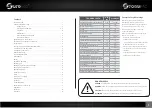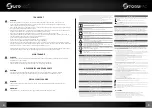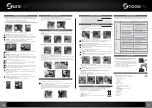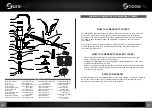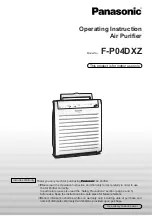
RECHARGING THE BATTERY
DANGER:
WARNING:
• Before charging check that the electric cable that connects the battery charger to the mains is not damaged,
and if it is damaged or broken, it should be replaced by either the manufacturer or by an authorised Surevac
service agent.
• Before charging check that the base of the battery charger is not damaged, and if it is damaged do not use it
and contact either the manufacturer or an authorised Surevac service agent.
• The socket for the battery charger cable must have an earth connection.
• Keep sparks, flames, heat, and incandescent materials at a safe distance from the batteries and the battery
charger.
• Charging the batteries produces highly explosive hydrogen gas, carry out the procedure only in areas that are
well ventilated and away from open flames.
• The battery charger must only be used in a covered area.
• Do not use the battery charger in potentially explosive environments.
• The batteries must be clean and dry when they are inserted in the battery charger.
• Before starting to charge the batteries, check there is no stagnant water or humidity in the on-board battery
charger socket.
• Do not disconnect the power cable of the battery charger from the socket of the machine when the battery
charger is operating to avoid electric arcs forming.
• Charge the batteries (2x # 207286) with the battery charger (#207440), both present in the packing, do not
use any other type of battery charger.
• We suggest that you charge the batteries after every use.
• Always recharge the batteries at a room temperature between 10°C and 40°C. Recharge the batteries using
only the power supply unit supplied with the appliance. Do not attempt to recharge damaged batteries.
• Keep a safe distance from flames or sparks when using this product.
• Before using the battery charger, make sure that the frequency and the voltage values indicated on the
machine's data plate coincide with the local network.
• Do not smoke near the battery charger, during the charging cycle.
• Carefully read the user manual of the battery charger before recharging.
• Do not attempt to open the batteries for any reason whatsoever. Avoid any contact with the liquid that seeps
out of damaged batteries. If necessary, rinse the area of skin which came into contact with the liquid in water;
in case of contact with eyes, rinse thoroughly and seek medical advice.
• Do not let the batteries get dirty or wet.
• The batteries must not be exposed to excessive heat (e.g. sunshine, flames, etc.). Do not leave the batteries in
places where the temperature could exceed 40°C.
• The battery contacts must not touch metal parts, to avoid any risk of short-circuits.
• The batteries must be kept far from metal objects, to avoid any risk of short-circuits.
• Do not throw the batteries into a fire.
• Do not throw a battery away with domestic waste; respect the disposal regulations in force in the country
where the appliance is used.
• This appliance is not intended for use by persons (including children) with reduced physical, sensory or mental
capabilities.
• Children should be supervised to ensure that they do not play with the appliance.
DANGER:
• To power the appliance, use only the batteries supplied in the package.
• OTHER BATTERY TYPES CANNOT BE USED. The appliance is powered by 2X lithium-ion batteries.
• The appliance must not be used or kept outdoors, in damp conditions or directly exposed to rain.
• The storage temperature must be between -25°C and +40°C.
• Conditions of use: ambient temperature between 0°C and 40°C with a relative humidity between 30 and 95%.
• The vacuum cleaner has been developed only for dry cleaning and it should not be used or kept outdoors in
moist conditions.
• Before using, make sure the appliance is in a good condition. If that is not the case, remove the batteries and
cease use of the appliance.
• When the appliance is used in dangerous situations (for example filling stations) the relative safety
regulations must be followed. It is forbidden to use the appliance in areas with a high risk of explosion.
• Certain substances can form explosive vapours and mixtures together with intake air.
Never vacuum the following substances:
• Explosive or inflammable gases, liquids and powders (reactive powders).
• Reactive metal powders (for example aluminium, magnesium, zinc) together with strongly alkaline
detergents and acids.
• Acids and alkalines in their purest state.
• Organic solutions (for example gasoline, paint thinners, acetone or gasoline).
WARNING:
• Keep hair, loose clothing, fingers and all body parts away from openings and from moving parts.
• Do not put objects into the openings or use the appliance with the opening blocked. Keep the openings
free of dust, fur, cloths, hair, and everything else that can reduce the air flow.
• This appliance is not suitable for vacuuming dangerous powders.
• Do not use to vacuum flammable or combustible liquids like gasoline, or use in areas where they may be
present.
• Do not vacuum anything that is burning or smouldering, like cigarettes, matches or glowing embers.
• The appliance should only be used by people trained in its use and who have shown that they know how to
use the appliance and have been expressly authorised to do so.
• This appliance should only be used in enclosed areas.
• Never leave the appliance unattended when the batteries are connected. Remove the battery when not in
use and before any maintenance.
• Never use the appliance near burning or smouldering objects.
• It is forbidden to vacuum persons or animals with this appliance.
• This appliance should not be used outdoors.
3
2


